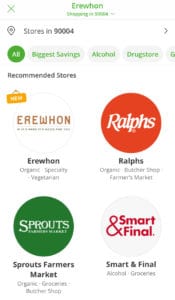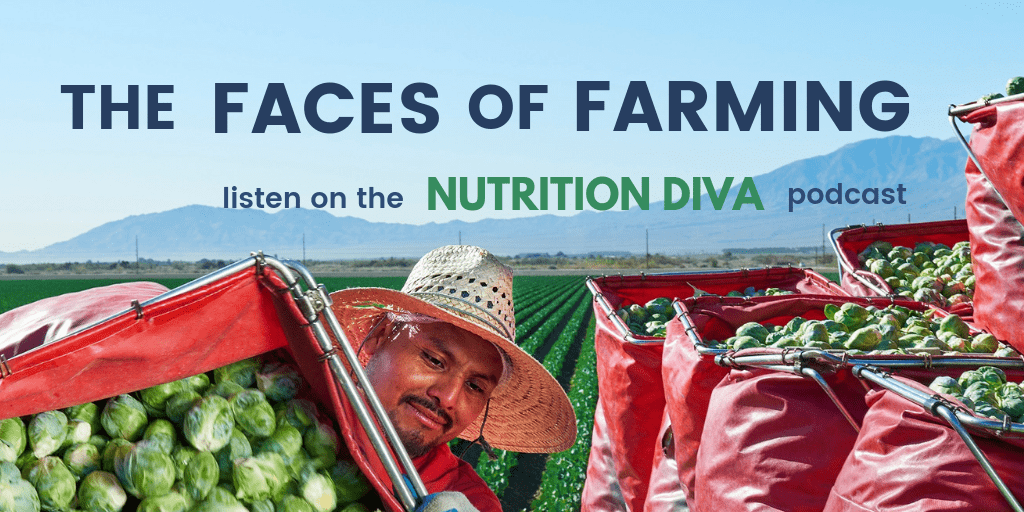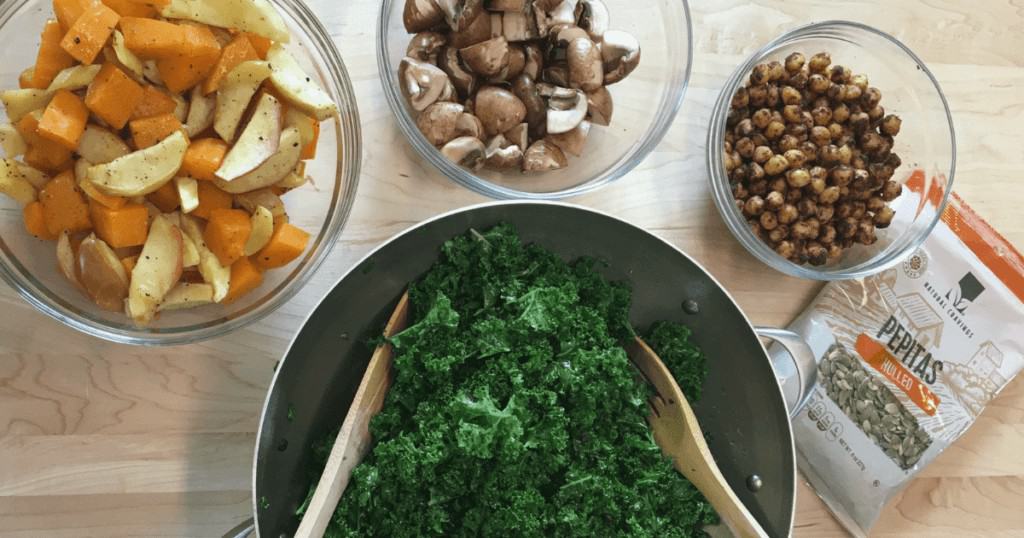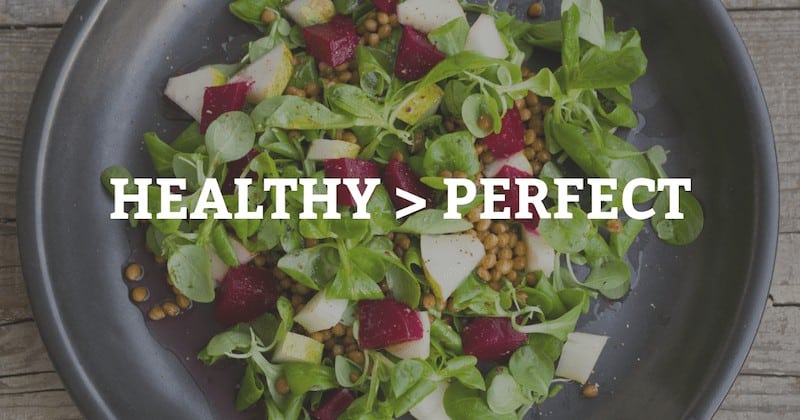Isn’t it kind of obvious that soymilk contains soy? So why would they print that underneath the ingredient list? It’s all about the Food Allergen Labeling and Consumer Protection Act of 2004.
Category: Healthy Eating Tips
Practical tips for improving your nutrition
Six Free Apps That Will Make Meal-Prep Easier
Though applications are supposed to make your life easier, sometimes finding the right app can be a challenge. A “meal planning” search in the App Store yields pages of tools that claim to help you conquer the grocery store, step up your lunchbox game and make peace with your plate, but how can you know which apps are actually effective? After lots of downloading and deleting, I’ve put together a list of six free apps that have allowed me to spend more time enjoying my food rather than preparing it. These apps are available for both iPhone and Android users.
#1. Instacart: Best for buying groceries when you don’t have time to shop
 As a nutrition coach in University of Maryland’s Health Center, I’ve found that my clients who grocery shop regularly are more likely to meet their nutritional goals compared to those who do not. This makes sense, as it’s pretty hard to eat healthfully if you lack nutritious foods in your home. With the Instacart app, you can have fresh produce delivered to your home with the literal flick of your finger. Not having time to make it to the grocery store will no longer be an excuse for not eating healthfully.
As a nutrition coach in University of Maryland’s Health Center, I’ve found that my clients who grocery shop regularly are more likely to meet their nutritional goals compared to those who do not. This makes sense, as it’s pretty hard to eat healthfully if you lack nutritious foods in your home. With the Instacart app, you can have fresh produce delivered to your home with the literal flick of your finger. Not having time to make it to the grocery store will no longer be an excuse for not eating healthfully.
 After typing your zip code into Instacart, a list of stores in your area will come up on your screen. After selecting a store, you can use the search bar to quickly find and order specific items, or, for a more authentic grocery store experience, you can add items to your cart as you peruse the different categories. You can also access Instacart online. Though the Instacart app is free, the order must be at least $10 to be eligible for delivery, and there is a $3.99 delivery fee (some of this money goes toward tipping the driver). You can subscribe to Instacart Express ($9.99/month or $99/year) to avoid this fee on orders above $35. Have fun portable grocery shopping!
After typing your zip code into Instacart, a list of stores in your area will come up on your screen. After selecting a store, you can use the search bar to quickly find and order specific items, or, for a more authentic grocery store experience, you can add items to your cart as you peruse the different categories. You can also access Instacart online. Though the Instacart app is free, the order must be at least $10 to be eligible for delivery, and there is a $3.99 delivery fee (some of this money goes toward tipping the driver). You can subscribe to Instacart Express ($9.99/month or $99/year) to avoid this fee on orders above $35. Have fun portable grocery shopping!
Continue reading “Six Free Apps That Will Make Meal-Prep Easier”
Quick Guide to Complementary Protein Sources
In this week’s Nutrition Diva podcast, I talk with protein researcher Douglas Paddon Jones about whether or not there’s any benefit to combining complementary plant-based protein sources at the same meal.
Contrary to a lot of the conventional wisdom, which claims that it’s sufficient to get all of the essential amino acids over the course of a single day, Dr. Paddon Jones argues that a meal-based approach to protein nutrition will enhance the ability to build and maintain lean muscle tissue.
This doesn’t mean you have to tally up and micro-manage each individual amino acid. The following chart shows how to choose meal components that will ensure complete proteins at a meal.

If you consume only plant-based proteins, you may also want to increase your total protein intake by 10-20% to compensate for the lower digestibility of these plant-based protein.
The Recommended Daily Allowance for protein is 0.8 g per kg of body weight (or 0.36 g per pound). Strict vegetarians may want to aim for a minimum of 1 g per kg (or 0.45 g per pound).
These are these are minimum recommended intakes. Research suggests that there may be benefits to higher protein diets, especially for athletes, the elderly, those recovering from surgery or illness, or during weight loss. If you’re in any of these groups, you might want to aim for something closer to twice the recommended minimum.
What are the best and worst kinds of fruit?
In this week’s Nutrition Diva podcast, I debunked the myth that you should avoid certain types of fruit, either because they are higher in sugar or higher in fructose.
All fruit can be part of a healthy diet–especially if you are eating fruit in place of other less healthy choices.
But if you’re curious to see how various types of fruit stack up in terms of total sugar content as well as fructose and glucose content, here’s a chart of some common fruits. You can click on any column to sort by that value.
| Fruit (1 cup serving) | Total Sugars (g) | Fructose (g) | Glucose (g) |
|---|---|---|---|
| Raisins | 108 | 57 | 50 |
| Dates, medjool | 86 | 42 | 44 |
| Figs, dried | 71 | 34 | 37 |
| Apricots, dried | 69 | 16 | 43 |
| Plums, dried (prunes) | 66 | 22 | 44 |
| Bananas | 28 | 11 | 11 |
| Grapes | 23 | 12 | 11 |
| Mangos | 23 | 8 | 3 |
| Tangerines | 21 | 5 | 4 |
| Cherries | 18 | 7 | 9 |
| Plums | 16 | 5 | 8 |
| Pineapple | 16 | 4 | 3 |
| Kiwi | 16 | 8 | 7 |
| Grapefruit | 16 | 4 | 4 |
| Blueberries | 15 | 7 | 7 |
| Apricots, fresh | 14 | 1 | 4 |
| Oranges | 14 | 4 | 3 |
| Cantaloupe | 14 | 3 | 3 |
| Honeydew | 14 | 5 | 5 |
| Pears | 14 | 9 | 4 |
| Peaches | 13 | 2 | 3 |
| Papaya | 11 | 5 | 6 |
| Apples | 11 | 6 | 2 |
| Nectarines | 11 | 2 | 2 |
| Watermelon | 10 | 5 | 2 |
| Strawberries | 7 | 4 | 3 |
| Blackberries | 7 | 3 | 3 |
| Raspberries | 5 | 3 | 2 |
| Cranberries | 5 | 1 | 4 |
| Source: USDA National Nutrient Database for Standard Reference |
How Much Fat Can You Lose?
The other day, I was browsing nutrition headlines when I came across a summary of some new research on exercise and fat loss, which concluded that “it is not possible to lose more than 1 kilogram of fat per month.” (A kilogram is just over 2 pounds).
Not possible to lose more than 2 pounds of fat per month? Most diets promise that you’ll lose that much every week!
This article is also available as a podcast. Click to listen.
Intrigued, I pulled up the actual study, which was published last month in the British Journal of Clinical Pharmacology, and read the whole thing. Weirdly, however, the study said absolutely nothing about the amount of fat that can be lost per month. The researchers were looking at the amount of fat that can be oxidized during a single exercise session.
So, I tracked down the researcher, Dr. Juan del Coso Garrigós, who lives and works in Madrid, Spain. He explained that his comment about it being impossible to lose more than 1 kilogram of fat per month in fact had nothing to do with his recent study. Apparently, it was taken out of context from a different part of the interview, which was also translated from Spanish. It just goes to show you how easy it is for bad information to get into widespread circulation.
As long as I had him, though, I took the opportunity to ask him more about his research. Dr. del Coso Garrigós explained that, when conditions are just right, well-trained athletes can burn about three-quarters of a gram of fat per minute during moderate intensity exercise. The rest of us seem to max out at about a half a gram of fat per minute or 30 g of fat per hour.
How Much Fat Can You Burn with Exercise?
At that rate, it’ll take most of us about 15 hours of moderate intensity exercise to burn a pound of body fat. Exercise for one hour a day, and you can hope to lose about 2 pounds (or about 1 kilogram) of fat per month. Exercise for longer than 60 minutes a day and you could hope to lose more. You can also get your body to oxidize fat by eating less, which forces your body to convert some of its fat stores into energy.
As Dr. del Coso Garrigós confirmed, it is theoretically possible to lose more than a kilogram of fat per month. That said, he and I both agree that losing more than a couple of pounds of body fat per month is both difficult and rare.
Of course, most diets promise that you’ll lose 8-10 pounds a month or more. And if you follow any of those diets faithfully, you probably will. But how much of that weight loss is actually fat loss? Probably no more than 25%. The rest is water and muscle tissue, which is the last thing you want to be losing. In fact, the faster you are losing weight, the smaller the percentage of actual fat loss is likely to be. And the harder it will be to sustain that weight loss over time.
I think the reason that a majority of dieters regain the weight that they’ve lost is that they lose weight too quickly. Instead of trying to lose 1-2 pounds a week, we should aim to lose 1-2 pounds a month. When we lose weight slowly, we preserve more muscle tissue and keep our metabolism from slowing down. We also are more likely to develop long-term habits and behaviors that will support long-term success. We avoid the yo-yo dieting cycle that sabotages both our health and our self-esteem.
Of course, when you’re losing weight very slowly, it’s hard to see the results on the scale, especially because your weight can fluctuate by several pounds from day to day without reflecting actual fat loss or gain. That’s why I recommend tracking your weight using a moving average, as described in my episode on Weight Fluctuation (#199).
How to Lose Two Pounds a Month
So, what would it take to lose 1 to 2 pounds a month? The good news is that it doesn’t require anything nearly as drastic or unpleasant as it takes to lose 2 pounds a week! Small changes in your daily routine will do the trick. You just need to be consistent and patient.
Here are some of my favorite slow weight loss strategies:
- Avoid eating in front of the television or computer.
- Cut back on alcoholic beverages
- Eat more vegetables and fewer starches.
- Use smaller dinner plates
- Decide what you’re going to eat ahead of time
- Drink water or tea instead of sweetened or artificially sweetened beverages
- After losing some weight, take a break before losing any more.
You don’t need to do all of these at once. Start with a couple that seem easy and one that seems like a bit more of a challenge. Add more as you get the hang of it.
Don’t think of it as dieting. Think of it as right-sizing. And, please, let me know how it’s going.
This article was originally published at QuickandDirtyTips.com
How to Meal-Prep Like a Dietitian
The list you scribbled in the car five minutes ago rests between your fingers and the grocery cart’s handlebar as you embark on what you hope will be a quick grocery run. As the produce section starts to feel like a corn maze and the frozen aisle makes your brain freeze, you wonder how people manage to conquer this meal-prep thing weekly. If this sounds like your typical grocery run, then these dietitian-approved meal-prep tips might be for you.
- Understand the value. Before heading to the store, you should recognize that cooking meals is about self-care, says Julie Duffy Dillon, a North Carolina-based registered dietitian and eating disorder specialist. She adds that meal-prepping should not be stressful. “It’s compassionate to you and your family,” Dillon explains.And being organized about meals can help you reach your nutritional goals, Claire Chewning, an R.D. and blogger located in Virginia, said. “You have to align your actions with your intentions.”
- Plan strategically. “Meal-prep doesn’t have to take place on Sunday afternoons,” Rachel Meltzer Warren, a New York-area R.D. and nutrition writer says, though many find that to be a convenient time. Using grocery delivery apps and preparing food in increments can help you “carve out time in a busy schedule,” she adds. It’s also helpful to “know when your energy is,” University of Maryland’s campus dietitian, Jane Jakubczak, says, laughing while explaining that she makes salmon at 6 a.m.
- Shop smart. Having a general idea of the foods you want to purchase can minimize food waste, Warren says. She advises clients to fill out grids – which become grocery lists – when mapping out meals for the week. “I know I have big eyes when I shop,” Warren says, chuckling. “If I have no plan, I grab everything, and [then] the food goes bad.”
Meal Planning on the Fly
To stay on track when shopping while still allowing room for creativity, Chewning considers each meal as a triangle; it’s three points are the macronutrients. “At every meal, if you want full balance to keep you satiated and to keep all the little cells in your body happy, you have a protein, you have a carbohydrate and a healthy fat,” she said. “In the center of the triangle, you have a big empty space, and that’s where fruits and vegetables come in.”
The carbohydrate sources Chewning, a lacto-ovo vegetarian, enjoys include rice, potatoes, peas, beans and corn. For protein, she likes tofu, seitan and fish prepared in olive oil, a healthy fat. “If I plan to have those foods cooked, it gives me the freedom and the ease to eat them in a way that sounds good to me at that moment in time,” Chewning said.
Jakubczak purchases salmon, chicken and lean meats in bulk, the cheapest option per-unit, she says. After cooking proteins on Sundays, she portions them into labeled containers and freezes them – essentially “creating [her] own frozen food.” She takes the containers out to thaw and uses a microwave to accelerate defrosting before mealtimes. “If we don’t plan and prep in advance, it’s almost too easy to get take-out,” Jakubczak says. “Make the healthy option the easy option.”
- Plan for chaos. A busy schedule shouldn’t stop you from consuming balanced meals and snacks. Dillon plans to cook two longer-to-prepare recipes, two 15-minute recipes and one “super easy” recipe weekly, for nights when “life happens.” Warren keeps frozen riced cauliflower on hand to fry with tofu and eggs for times when she lacks fresh ingredients. Jakubczak bags vegetables and portions watermelon into containers in advance so she can grab them on busy mornings. “Prepare to be unprepared,” Warren says. “Have ideas that can be thrown together without much prep.”
- Make it simple. “In the end, having canned peas versus fresh peas isn’t going to make a difference,” Dillon says. “If you can try not to be too [much of a perfectionist] or all-or-nothing, then you will be able to be honest with where you are now. Then you’ll be able to start cooking.”
 Dena Gershkovich is a dietetics and journalism double major at the University of Maryland, College Park. She is hoping to become a registered dietitian and nutrition writer. To read more of Dena’s work, check out her blog, The Artsy Palate, for original recipes and tips for how to stay healthy in college and beyond.
Dena Gershkovich is a dietetics and journalism double major at the University of Maryland, College Park. She is hoping to become a registered dietitian and nutrition writer. To read more of Dena’s work, check out her blog, The Artsy Palate, for original recipes and tips for how to stay healthy in college and beyond.
Healthy is Better Than Perfect: 5 Must-Know Insights
Ever feel like you have to do something dramatic to turn your diet around or get a grip on your eating habits? Like put a lock on your pantry or only drink green juice?
All that drama isn’t necessary. And the participants in my 30 Day Nutrition Upgrade program are proof: eating healthy doesn’t mean restricting yourself or being anywhere close to “perfect.”
Here are 5 takeaways participants had (along with extra resources) to help you bring balance into your own diet:
1. Perfection isn’t the goal. Awareness is.
“I weighed myself for the first time since doing the 30-Day Nutrition Challenge and was down 8.5 lbs, all because I was more aware of the type of food I was eating.”
A little awareness can go a long way. A lot further than a set of arbitrary rules which, once you break them, ultimately lead to giving up. If mindful eating sounds like a drag or a bore, check out this podcast episode on How We Get Mindful Eating Wrong.
2. You can stay on track without logging everything you eat.
“This approach keeps me mindful of what I’m eating without all the logging.”
Keeping a record of everything you eat can be a very effective tool for improving your eating habits. Most people start to drift away from the habit after a week or two–often, when they have a day they’d just as soon be “off the record.” And the benefits of that increased awareness and accountability gradually slip way.
The Nutrition GPA app was developed as a solution to this dilemma–a way to get the benefits of awareness and accountability without the burden of logging every bit of food every day.
3. Adding foods is more fun than subtracting.
“It hasn’t seemed like the ‘I can’t wait until this is over’ diet plan.”
Improving your nutrition isn’t just about eliminating unhealthy foods. It’s also about adding healthy ones!
4. Bad days don’t have to mean reaching for Ben and Jerry’s.
“I’m far less likely to succumb to bad choices in weak moments.”
Strict dieting rules often lead to an all-or-nothing attitude. One moment of weakness derails the entire project. Not so in the 30-Day Nutrition Upgrade. Although we use the Nutrition GPA app as a way to get feedback on our daily choices, perfection is not the goal. Cultivating consistent healthy habits means there’s room for a little indulgence too.
But if your sweet tooth is your weakness, here’s something that can help keep those sugar cravings from getting the better of you.
5. Remember: it’s a lifestyle, not a sprint.
“This is a lifestyle I intend to keep up.”
And when it comes to healthy habits, the ones we can sustain long term are the only ones that really make a difference. I’d rather see you cut your added sugar intake by 25% forever than to go 30 days without any added sugar at all…and then go back to your old habits. Remember: it’s not your best days or your worst days but your typical day that ultimately determines the quality of your diet and your results!
Congratulations to all the recent Upgraders. If you’d like to do your own 30 Day Nutrition Upgrade, you can sign up here.
For what are we grateful? Let’s start with these people

Every Thanksgiving we prep the turkey, mash the potatoes, dice, slice, and garnish the side dishes, and set the table. Finally, the feast is spread before us and we go around the table, each saying what we’re grateful for.
“Family.”
“Friends.”
“The food we’re about to eat.”
But how often do we think to extend our gratitude to the farmers who made it all possible?
Farmers are often the unseen faces behind the food that fills our bellies. As we focus on what’s in front of us, it’s all too easy to overlook their crucial role.
It’s not just a farmer’s job to grow and produce the food we eat. It’s their life’s work–and it’s truly a labor of love: love for the land, for the earth and its precious resources, for the communities that they nourish and support. All the dedication it takes to get the fruit, vegetables, dairy, and meat to our table deserves much more of our awareness and gratitude.
Especially because agriculture is dwindling in the United States. A hundred years ago, 1 in 4 Americans was employed in agriculture. Today it’s just 1 in 50. At the same time, we have over 3 times as many people to feed.
[bctt tweet=”A hundred years ago, 1 in 4 Americans was employed in agriculture. Today it’s just 1 in 50.” username=”nutritiondiva”]
Over the past couple of years, I’ve had the opportunity to meet some of the people who dedicate their lives to feeding us. And I want you to meet them too.
That is why, in the weeks leading up to the American Thanksgiving holiday, I’ve been talking to some people who are helping bring that feast (as well as our everyday meals) to our table on the Nutrition Diva podcast.
You can hear the entire series on Apple Podcasts, Stitcher, Google Play, Spotify or wherever you like to listen to podcasts or scroll down to listen here.
The Faces of Farming from the Nutrition Diva Podcast
Faces of Farming #1: Hear from Dale Huss, as he shares the challenging realities of growing and managing his crops, the risks and rewards, and the pride that comes from producing a great harvest.
Faces of Farming #: Meet Dr. Tera Barnhardt, coordinator of animal health and welfare for Cattle Empire, as she explains the ranch’s feeding operations, her “welcoming committee” approach, and how technology plays an unsuspected, yet vital role.
Faces of Farming #3: I speak with Tara Vander Dussen, a fifth generation dairy farmer. Learn about her journey to rediscover her heritage, the farm’s cow care, as well as the surprising (and famous) dairy specialty out of New Mexico.
Faces of Farming #4: Strawberry grower Greg France talks about how learning to grow organic strawberries changes how he thinks about farming, and a farmer’s unique connection to the land and his community.
Faces of Farming #5: LA native Brian Wahlbrink explains why he traded his surf board for a tractor and decided to dedicate his life to cultivating the world’s most popular nut.



